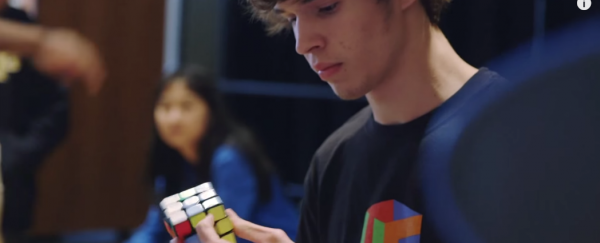Back in April, a 15-year-old American teenager from Central Bucks West High School in Pennsylvania shaved 30/100ths of a second off the world record for the 3x3x3 Rubik's Cube, solving it in just 5.25 seconds. The previous record was held by Mats Valk from the Netherlands, who set it at 5.55 seconds in 2013. "You just need to get lucky," current world record holder, Collin Burns, says in the Vox video above. "Or at least, that's a big part of it." All that self-deprecation is awfully charming, but any dreams you might have of 'fluking' a world record will be unceremoniously crushed once you see this kid's ridiculous technique - this is a record that requires just as much physical dexterity as it does mental process.
So how did he do it? Firstly, we've got to get the basics sorted out. For someone to attempt a Rubik's Cube world record that's verified by the World Cube Association, they will first need to have their cubes scrambled by volunteers according to instructions generated by a computer. This means that competitors all over the world will have to solve the same scramble, which ensures that they all start out on an equal footing.
If you're going for the world record in Rubik's Cube averages, you get five attempts, and the three middle scores are averaged to give you your final score. Nineteen-year-old Australian, Feliks Zemdegs, currently holds the best average time for solving a Rubik's Cube: 6.54 seconds. If you're going for a 'single solve' record, on the other hand, like the one Collin currently holds, you live and die by just one score.
But don't be intimidated. As the Vox video above explains, you might not have the makings of a world record holder, but there's nothing stopping you from learning how to solve one of these classic brain-teasers in a couple of minutes every time. Researchers have even found out that every single Rubik's Cube, no matter how it's scrambled, can be solved in 20 steps or less. "The biggest misconception about cubing is that it's difficult, which it really isn't," says Burns. (Let's just all take a moment to appreciate the verb "cubing".)
Where the 'speedcubers' are separated from the plebs is in efficiency - anyone attempting a world record will be thinking several steps ahead, and figuring out how to use fewer moves to get the same result. And that means expertly navigating through the 43 quintillion possible arrangements for a single cube.
Watch the video above to learn the Rubik's Cube 'beginner's method', which, if you're good enough, will lead you to the speedcuber's method. And then next step, world record? Just don't forget us when you're rich and famous and draped in cube-groupies, okay?
